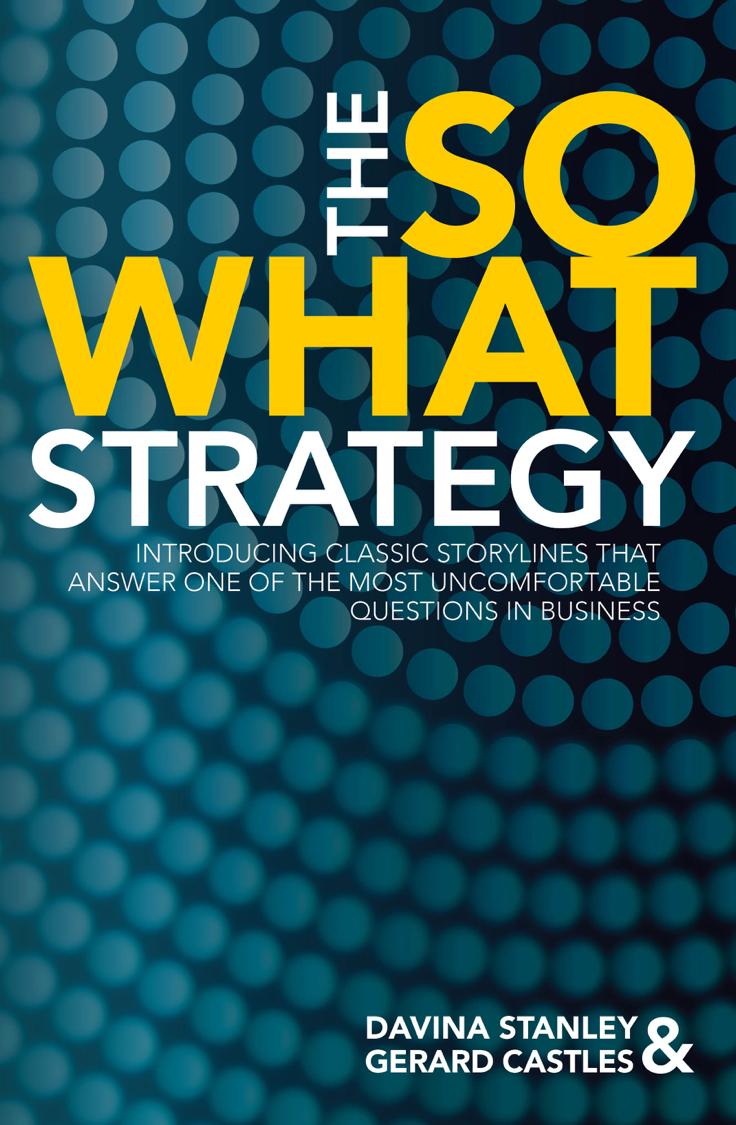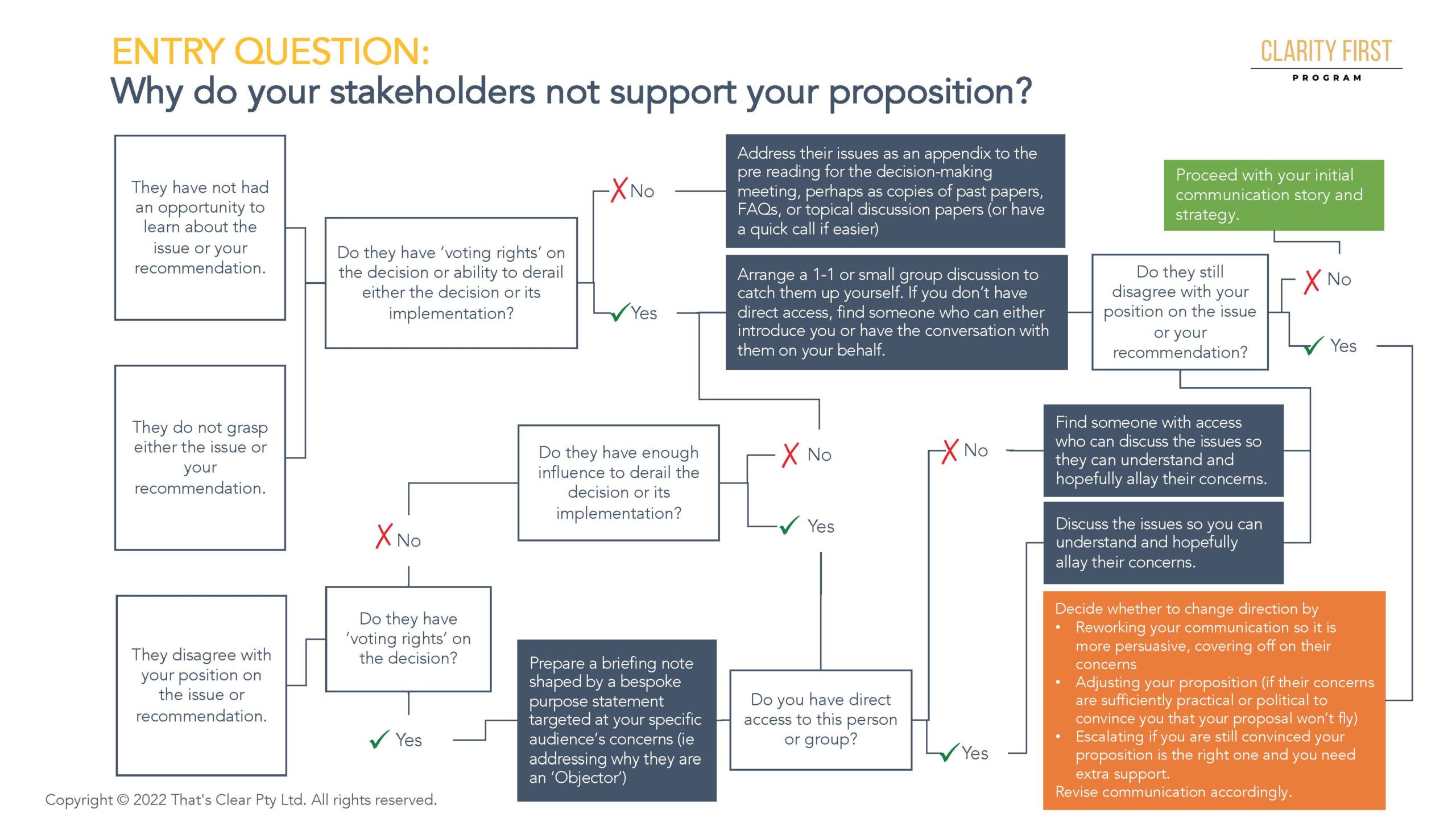×

LEARN MORE ABOUT THE WORKSHOP KIT
Enter your email below and we will keep you updated as more information is released about the kit.

This week I reviewed a ‘boat load' of client communication to provide feedback.
A common theme emerged, which you may find familiar?
Just because communication includes well-formed sentences organised tidily into categories doesn't mean it cuts the mustard.
And, the categories can be the problem.
To see an example and get some more ideas to help you with your communication, watch this recent workshop I ran.
I hope that helps. More next week.
Kind regards,
Davina
In Clarity First we introduce structured communication techniques to help you engage decision makers.
We go beyond platitudes like “keep it short” and “give me less detail” to teach you how to turn your information into high-quality insights.
Here are some resources to help you learn more about the program:
We offer three learning pathways to choose from
Intensive – for those who want structure and focus so they can move through the material and build their skills in 3 months. Includes 6 interactive workshops + online pre-work + copy of The So What Strategy + access to small group coaching. 30 places max. 12 already taken.
Classic – for those who want to learn in their own time and enjoy small-group coaching. Join on monthly or yearly subscriptions.
Foundation – for those who want more. Enjoy everything in the Intensive as well as the Classic pathways + 4 x speed coaching sessions + 6 x email feedback on your own work. 2 places only available.
>> Download the latest brochure here.
Get your ‘Pitch your boss' kit here
If you want your manager to invest in your development, you need to do your homework before you have the conversation.
Your manager will want to know exactly why this is the right program for you and how it will help the team and the organisation.
We have provided a brochure, a draft script and some steps to follow to help you prepare for your conversation.
>> Download the latest ‘kit' here.
See what others say here
A number of program members have shared their experience of Clarity First – warts and all.
Click here to see what they say.

I love what I do.
I help senior leaders and their teams prepare high-quality papers and presentations in a fraction of the time.
This involves 'nailing' the message that will quickly engage decision makers in the required outcome.
I leverage 25+ years' experience including
My approach helps anyone who needs to engage senior leaders and Boards.
Recent clients include 7Eleven, KPMG, Mercer, Meta, Woolworths.
Learn more at www.clarityfirstprogram.com
(*) Numbers are based on 2023 client benchmarking results.

Or, perhaps you are asked to shorten yours?
This is a common request that I think is misguided.
Let me explain why.
Stakeholders don't ask you to make your communication shorter because it's hard to read. They ask because it is too hard to read.
So, when you use ‘TLDR' … which for those of you who aren't familiar with this term means ‘To Long, Didn't Read', try this one instead:
THDR – Too Hard, Didn't Read
To see an example and get some more ideas to help you with your communication, watch this recent workshop I ran.
I hope that helps.
Davina

I love what I do.
I help senior leaders and their teams prepare high-quality papers and presentations in a fraction of the time.
This involves 'nailing' the message that will quickly engage decision makers in the required outcome.
I leverage 25+ years' experience including
My approach helps anyone who needs to engage senior leaders and Boards.
Recent clients include 7Eleven, KPMG, Mercer, Meta, Woolworths.
Learn more at www.clarityfirstprogram.com
(*) Numbers are based on 2023 client benchmarking results.

Like packing, structuring your thinking using the Pyramid Principle looks easy when it's done.
As I was packing my bags to return to Sydney I realised there was a parallel between my packing process and communicating using the Pyramid Principle.
Really?
Packing for the return trip was vastly easier than when we left for our one month away.
On the way out, it was quite an effort. There was so much to consider.
What would the weather would be like? The forecast kept changing for the Pacific North West, so I needed to be ready for anything.
What would we be doing? Did I need mainly casual clothes, or to factor in some smarter nights out? How much hiking would we do? Not sure.
I was also in a rush, as I left it late to pack.
The answer was to think carefully – and quickly – about multi-purposing and coordinating each item.
This meant items flurried in and out of the bag, with many things flying in and out at the last minute.
This made for a bulging, disorganised bag.
On the way home it was remarkably different.
Here are three ideas to cut the time it takes to structure your messaging:
That's right … nail the messaging before you open the Board paper template, PowerPoint … or whatever medium you are using.
I hope that helps.
Davina
PS – If you'd like to take these ideas further, try my free 10 Minutes to Better Emails course or check out my latest books.

I love what I do.
I help senior leaders and their teams prepare high-quality papers and presentations in a fraction of the time.
This involves 'nailing' the message that will quickly engage decision makers in the required outcome.
I leverage 25+ years' experience including
My approach helps anyone who needs to engage senior leaders and Boards.
Recent clients include 7Eleven, KPMG, Mercer, Meta, Woolworths.
Learn more at www.clarityfirstprogram.com
(*) Numbers are based on 2023 client benchmarking results.

It’s tempting to think that preparing papers and PowerPoints is a low-level skill mastered early in your career.
And in part that is true.
If you are a mid-level executive, you most likely have had some success in explaining how your project is progressing and seeking approval for more resources.
You will likely have improved on the examples your predecessor used to get there. You will also have added a few tips and tricks from the business writing and presentation skills training programs you have completed.
You may have engaged Board members in big decisions too.
But perhaps something is still niggling you?
You can see that you haven’t quite nailed ‘the magic’. Perhaps you are
At Clarity First we are confident that the missing ingredient is the ability to synthesise complex ideas into a single high-quality message.
Here's what that means:
Here's what this does not mean: Learning how to …
These things are a consequence of ‘nailing' your material and your message.
They are not the main game.
To extend your Thinking Skills, I invite you to explore the Clarity Hub. It's a fantastic resource for professionals like wanting to increase the impact of their communication.
It includes access to live workshops, tools and templates, a growing library of case studies, the incredible useful Pattern Picker and more.
Warm regards,
Davina
PS – While away on sabbatical I caught up with two long-term clients in person. One of them thanked me. He said :
Lots of people say they do what you do. But in my experience, none of them actually deliver on that.
Your process works. I can do it every time and I get the results I need.
I wish I knew about it earlier in my career.
It would have made such a difference.

I love what I do.
I help senior leaders and their teams prepare high-quality papers and presentations in a fraction of the time.
This involves 'nailing' the message that will quickly engage decision makers in the required outcome.
I leverage 25+ years' experience including
My approach helps anyone who needs to engage senior leaders and Boards.
Recent clients include 7Eleven, KPMG, Mercer, Meta, Woolworths.
Learn more at www.clarityfirstprogram.com
(*) Numbers are based on 2023 client benchmarking results.

Do you always have too much to do?
It's not entirely surprising since our only finite resource, time, is at the heart of the challenge.
Unsurprisingly, this is a pretty constant topic when coaching people on their communication.
How do we find enough time to think through our communication? How do we know when to prioritise thinking through a particular piece … or when ‘smashing it out' is the right strategy?
It's also top of mind for me as I head off for a month away on Tuesday. Yes, a month.
So, today I wanted to focus on ‘time' and share some ways to help us all take advantage of it rather than be held hostage to it.
I'd like to suggest we can ‘hack' time to enhance our work and our life by harnessing two thinking modes. This might be an odd idea, but let me give you the high-level first and then work through it in three parts.
I'll now expand on each of these further.
Two familiar thinking modes that we already use to allow time to do our work for us. Let me introduce them both:
I first learned about these from Barbara Oakley in her Coursera course, Learning How to Learn. You may also find this free course enjoyable.
Several modern writers offer ways for us to capitalise on the under-utilised ‘diffuse thinking' mode to enrich our work and life.
Without necessarily using this language, they all seem to me to be taking advantage of diffuse thinking mode.
Greg McKeown has written two excellent books on this subject. The subtitles for each sum up the key ideas:
Cal Newport of Deep Work fame offers ideas to avoid distractions so we can focus properly when at work and switch off when not. There is overlap between his work and Greg McKeown's, but I have found both to be great reads.
Alex Soojung-Kim Pang takes the ideas further and discusses the increasingly popular shorter work week. Again, his title and subtitle are instructive: Shorter: how working less will revolutionise the way you get things done.
His thesis is that if we focus harder during a shorter time period we are forced to change the way we work which he says is a good thing. This will force us to become both more efficient and more effective. We will change the systems we use, the way we use our time and help us deliver more over all.
He reinforces the idea that the extra time off helps us be happier and healthier. The beauty is that our time away from the office allows our ideas to ‘marinate' while we aren't ‘working'.
These are not the only people talking about these issues, but ones that I have read and enjoyed. All offer ways to rebalance their use of focused and diffused thinking in their lives.
So, with that background I'd like to share some of my own thinking on taking advantage of these two thinking modes in work and life.
Firstly, in work, particularly where problem solving and communication are involved.
Many of my clients leave thinking about their communication to the last minute. They want to finish their analysis first and then are understandably squeezed as the deadline looms. Or they don't have enough information about the communication context to start and so leave it until they have no choice but to begin.
As an alternative, I suggest this five step strategy to help us start thinking early so we can take advantage of these two thinking modes.
Secondly, in life. Now, this one is going to be different for everyone as demands on us and our life stages vary. I could be general here, but the authors I mentioned have offered good quality advice on the subject so I'll avoid that.
Instead, I'll explain why you won't be hearing from me for the coming few weeks. I'm taking July as a mix of holiday and sabbatical.
My husband and I are heading away for a month to celebrate our 30th wedding anniversary and to catch up with our 22 year old who has recently moved to New York.
We'll be taking the first couple of weeks away as a ‘proper vacation' and then using the second half of the break as a sabbatical. This will give us time and space to reimagine our life and work.
On my side, I'll be thinking about two things in particular:

I love what I do.
I help senior leaders and their teams prepare high-quality papers and presentations in a fraction of the time.
This involves 'nailing' the message that will quickly engage decision makers in the required outcome.
I leverage 25+ years' experience including
My approach helps anyone who needs to engage senior leaders and Boards.
Recent clients include 7Eleven, KPMG, Mercer, Meta, Woolworths.
Learn more at www.clarityfirstprogram.com
(*) Numbers are based on 2023 client benchmarking results.

I was reminded this week of why thinking and writing don't mix if you want to deliver impact at work.
It's great if you want to keep a journal, write a novel or perhaps some poetry.
But, bear with me.
I do believe writing helps us clarify our thinking.
But I also think writing to think inside a doc or a deck makes for poor business communication.
Communication quality is further reduced by socializing your document with others.
Let me offer three reasons why I believe ‘thinking' into a document leads to cluttered communication that takes far too long to deliver value.
Clarity of messaging is compromised as we seek useful input from others. In today's busy world, messaging must jump off the page the minute someone opens an email, paper or PowerPoint.
Asking stakeholders to review lengthy docs or decks leads to a mess of track changes that focus on the minutiae rather than the substance.
Quality of insight is hard to coalesce into a cohesive argument. If you draft your ideas inside an email, a doc or a deck you will naturally wander all over the place. Your thinking will evolve some here, some there as ideas form. The structure of your story and the quality of your messaging will wander likewise.
Velocity is nearly impossible. By velocity I mean the speed with which you can create your communication, with which your audience can digest it and then make a decision. When my clients skip using a one-page storyline they frequently see at least three problems. They see extensive rework, delayed decisions and lots of last minute scrambling to ‘fix' their docs and decks.
As one CEO said to me recently:
I hope that helps.
Warmly,
Davina

I love what I do.
I help senior leaders and their teams prepare high-quality papers and presentations in a fraction of the time.
This involves 'nailing' the message that will quickly engage decision makers in the required outcome.
I leverage 25+ years' experience including
My approach helps anyone who needs to engage senior leaders and Boards.
Recent clients include 7Eleven, KPMG, Mercer, Meta, Woolworths.
Learn more at www.clarityfirstprogram.com
(*) Numbers are based on 2023 client benchmarking results.

Are you so close to your work that you lose sight of what it's all really for?
It's interesting to me how I for one forget the obvious.
I move forward forgetting that what is obvious to me is often not obvious to others.
I was again reminded of this today in an advanced workshop with one of my government clients.
We were using a ‘pattern flipping' technique, which involves some fairly sophisticated mental gymnastics.
We play with storyline patterns to create new ones that better frame the story we need to tell.
This is more helpful to this client than most because their stories are huge and incredibly complex.
So, here's the thing.
To make ‘flipping work', I have to see storylines as a thinking machine that helps me work out what my message is. They are not a template to fill in.
To me this is pretty ‘ho hum'.
Of course they are! I use them all day every day.
But to see the light turn on in my clients' eyes around this was magic.
Here's what happened. They did five things …
Stopped being so literal and started to think. They began focusing on how to tweak a pattern so it suited their purpose, rather than taking a quick look at the favourite seven and saying ‘that'll do'.
Began to lean into how a storyline structure can highlight thinking problems. They could find and fix thinking problems by testing the ‘rules' that hold the ideas together.
Went beyond ‘clarity' to deliver ‘insight'. They started drawing out powerful and insightful messages rather than delivering something accurate and on topic but not impactful.
Saw how much faster they went if they started slow. Although storylining can be time consuming and mentally taxing, they saw how much time they saved by slowing down enough to think at the start.
Realised how much more value they could deliver. Less time reworking papers, speaking to people who don't respond to emails or don't ‘get' the message they are conveying. Better clarity of message. Greater quality of insight. Greater velocity of business.
I hope that helps.
Warmly,
Davina

I love what I do.
I help senior leaders and their teams prepare high-quality papers and presentations in a fraction of the time.
This involves 'nailing' the message that will quickly engage decision makers in the required outcome.
I leverage 25+ years' experience including
My approach helps anyone who needs to engage senior leaders and Boards.
Recent clients include 7Eleven, KPMG, Mercer, Meta, Woolworths.
Learn more at www.clarityfirstprogram.com
(*) Numbers are based on 2023 client benchmarking results.

We talk a lot about the clarity of communication. To me that means how easy it is for a person in our audience to grasp what we are saying.
This is, I suggest, only ground level for powerful business communication.
The next level is to deliver a high-quality message. By my way of thinking this is a message that is not just clear, but which delivers significant value.
In most situations this requires a good degree of synthesis, and I thought sharing four key questions we ask might help you assess the quality of your own communication.
To test the quality of our messaging, we ask ourselves what level of message we have used.
I encourage you to review the three most recent pieces of communication you have prepared and assess what level your communication was at.
If you find very few level 4 messages ask yourself why and see if you can level them up in your next piece.
I hope that helps and look forward to bringing you more next week.
Davina

I love what I do.
I help senior leaders and their teams prepare high-quality papers and presentations in a fraction of the time.
This involves 'nailing' the message that will quickly engage decision makers in the required outcome.
I leverage 25+ years' experience including
My approach helps anyone who needs to engage senior leaders and Boards.
Recent clients include 7Eleven, KPMG, Mercer, Meta, Woolworths.
Learn more at www.clarityfirstprogram.com
(*) Numbers are based on 2023 client benchmarking results.

I didn't expect the results from my ‘quick and dirty' prose v PowerPoint survey to land where they did.
Let me share the findings and observations with you and draw my conclusion.
The findings – In asking people what communication form their organisations use for discussing important decisions, prose wins hands-down. Here are the results:
My observations – I was surprised at the degree of the skew toward prose given I am often asked to help people with their PowerPoint presentations. Two things stood out:
My conclusion – I guess I am not as alone as I thought in my growing concern about the challenges and potential ineffectiveness of PowerPoint.
I do think it's a useful tool, but increasingly agree with Jeff Bezos that it can get in the way of powerful messaging.
Kind regards,
Davina

I love what I do.
I help senior leaders and their teams prepare high-quality papers and presentations in a fraction of the time.
This involves 'nailing' the message that will quickly engage decision makers in the required outcome.
I leverage 25+ years' experience including
My approach helps anyone who needs to engage senior leaders and Boards.
Recent clients include 7Eleven, KPMG, Mercer, Meta, Woolworths.
Learn more at www.clarityfirstprogram.com
(*) Numbers are based on 2023 client benchmarking results.

I had a fabulous question this week: where do we fit ‘pros' and ‘cons' in our storyline?
That is a ‘ripper' of a question.
My answer is this: lists of pros and cons don't belong in your communication, they help you think through that message.
Let me explain.
If we provide lists of pros and cons for an idea, we are providing information rather than insight. This matters, because in taking this approach we
If, instead, we do the thinking for our audience, we will deliver insights that emerge from our own analysis of the pros and cons list.
Although more intellectually challenging, this is better for us and our audience. We know more about the area than they do and we don't miss the opportunity to share our value add.
If your audience is explicitly asking for pros and cons lists, pop them in the appendix. Focus your main communication around your interpretation of that list.
Hopefully next time they won't ask for the list, but rather for your insights.
I hope that helps.
Kind regards,
Davina

I love what I do.
I help senior leaders and their teams prepare high-quality papers and presentations in a fraction of the time.
This involves 'nailing' the message that will quickly engage decision makers in the required outcome.
I leverage 25+ years' experience including
My approach helps anyone who needs to engage senior leaders and Boards.
Recent clients include 7Eleven, KPMG, Mercer, Meta, Woolworths.
Learn more at www.clarityfirstprogram.com
(*) Numbers are based on 2023 client benchmarking results.

Love or hate Jeff Bezos, he has had some very very good ideas when it comes to decision making communication.
I was talking about one of these with a client earlier this week. Given she liked the ideas and planned to implement them, I thought I'd share them with you also.
The most prominent idea relates to avoiding PowerPoint in favour of tightly crafted prose narratives to maximise quality decision making. Let me explain the two key ideas my client found so useful.
Avoid PowerPoint presentations. In relying on Edward Tufte's work on visualising information, ‘Jeff' decided to ban PowerPoint for reasons that seem sound to me.
Here's what they do instead.
Rely on short, tightly crafted prose narratives instead. They don't insist on any particular way of writing these, just that they be short and effective in setting up a great discussion. Their use in meetings is, however, prescribed as follows. The papers are
I hope that provides some useful food for thought.
Kind regards,
Davina
PS – I am curious to see what tools your organisations use.
If you click the relevant link below, I'll see the tally and can factor this into my program design for you.
In my organisation, decision making papers are …
When you click the link it will take you to a post on my website that offers some ideas on different ways to think about communication.
I'll let you know the results next week.
May 27th
Moving away from PowerPoint shines a light on the need to craft a really crisp narrative.
We can no longer hide or ad lib: we must think hard to connect the dots between our ideas no matter how complex the material.
Learn the foundational skills for untangling complex ideas so you can move from delivering ‘information' to conveying insightful, high-quality messages that are easily understood.

This week I received two requests to help with presentation skills, one for a finance professional and one for a group of about 80 analysts.
In both cases presentation skills were not the main issue.
In my opinion, they were just ‘tip of the iceberg'.
The real problem lies in synthesising findings into a clear, insightful, outcome-oriented message.
Let me explain with a diagram and then the back story.

From what I could see, the issue that I was being asked to solve: ‘standing with confidence' and ‘projecting their voice', were the least of their problems.
In both cases, presenters lost confidence when they received the wrong kinds of questions that led to the wrong kinds of discussions … and slow or no decisions.
When messages are not well synthesised decision makers ask questions that help them understand the message. This often involves diving into minute detail as decision makers attempt to do the thinking work themselves.
I see this most when recommendations are buried among a long series of facts. It forces decision makers to connect the dots between the facts, which leads them to lose the thread. This in turn leads them to ask questions to clarify the message rather than discussing the issue.
Conversations become convoluted, at times feeling more like an interrogation than a discussion. They also rarely lead to a high-quality or fast decision.
This is frustrating for all concerned and why I prioritise thinking skills.
I teach you to connect the dots into a well-synthesised message, so your audience doesn't have to.
I regularly hold a Thinking Skills MasterClass to uncover the skills essential to synthesising powerful messages.
This will then help you receive the right kinds of questions … and enjoy greater confidence when presenting your ideas in any forum.
Kind regards,
Davina

I love what I do.
I help senior leaders and their teams prepare high-quality papers and presentations in a fraction of the time.
This involves 'nailing' the message that will quickly engage decision makers in the required outcome.
I leverage 25+ years' experience including
My approach helps anyone who needs to engage senior leaders and Boards.
Recent clients include 7Eleven, KPMG, Mercer, Meta, Woolworths.
Learn more at www.clarityfirstprogram.com
(*) Numbers are based on 2023 client benchmarking results.

This is an unusual post but one I hope will help.
I just responded to a post by an old friend, Dr James Muecke who happened to be Australian of the year in 2020 for his work fighting sugar.
Look at how well he simplified and shared the message ….
Great (cheeky?) use of humour – Zits away …?
Demonstrates credibility – This recent systematic review concludes that “high glycemic index, increased glycemic load, and carbohydrate intake have a modest yet significant proacnegenic effect.”
Simple and visual summary – In other words, sugar => pimples
Clear takeaway that had me thinking about the young people in my own family – This might just motivate your kids to reduce their sugar intake …
Although I would have reordered these points for greater impact, I was thoroughly impressed by the simplicity and the timing (given many of us are about to binge on chocolate during Easter!).
I hope that helps.
Kind regards,
Davina


I love what I do.
I help senior leaders and their teams prepare high-quality papers and presentations in a fraction of the time.
This involves 'nailing' the message that will quickly engage decision makers in the required outcome.
I leverage 25+ years' experience including
My approach helps anyone who needs to engage senior leaders and Boards.
Recent clients include 7Eleven, KPMG, Mercer, Meta, Woolworths.
Learn more at www.clarityfirstprogram.com
(*) Numbers are based on 2023 client benchmarking results.

I came to Friday's interview with Matt Lohmeyer a bit selfishly. Negotiating has often made me nervous and yet he seems to thrive while discussing and doing it.
So, I wanted to learn how he gets great outcomes while actually enjoying the process.
If I am to interpret Matt correctly, the ‘insight' is to explore ‘possibility’ and seek out ‘opportunity’ rather than be driven by the fear of being cornered by a win/lose proposition.
Here are three fear busters that I took away that I hope help you also.
Let me now give you some more detail about these before offering the video recording and two powerful and free tools from Matt.
1 – Deal with the hairy beasts first. By that, Matt suggests dealing with the most difficult issues of a negotiation first. He recommends agreeing the negotiation strategy at the beginning as a way to build rapport, rather than dealing with small items. An example might help.
At the beginning you might ask the other person (note, I am deliberate in not saying ‘the other side') to identify their biggest concern. You might even suggest that you think item X is going to be the most difficult thing to resolve.
This gives them an opportunity to agree or to indicate that item Y or Z is a bigger deal for them. Taking this approach offers many advantages. You
2 – See popular techniques as tools rather than the primary strategy. Matt suggests that emphasising win-win solutions or splitting the difference results in mediocre outcomes. Why?
Because they leave you thinking small. They lead you to
3 – Avoid saying no, and frame your response as a possible alternative. This doesn't mean NEVER saying no as Matt was quick to point out, but rather avoid saying it.
To give an example. Instead of saying ‘No, I can't have coffee with you tomorrow afternoon', say ‘I could have coffee with you at 9am tomorrow at a location near me'.
This then puts the onus back on the other person to decide whether they will make the extra effort to make that time and location work.
This is a simple example, but a powerful principle that empowers me by offering a constructive way out.
These are just some of the gems that Matt shared. You can visit the recording below as well as download two powerful resources he has for us all.
1. A diagnostic to help you calibrate your personal blend of preferred negotiation strategies with the norm group of over 2,500 other executives. How do you actually negotiate? To unlock this tool, you will need to use the password Mythbusters.
2. A generously detailed PDF full of negotiation strategies for you to employ – register below to receive access to Matt's eBook:
Kind Regards,
Davina

I love what I do.
I help senior leaders and their teams prepare high-quality papers and presentations in a fraction of the time.
This involves 'nailing' the message that will quickly engage decision makers in the required outcome.
I leverage 25+ years' experience including
My approach helps anyone who needs to engage senior leaders and Boards.
Recent clients include 7Eleven, KPMG, Mercer, Meta, Woolworths.
Learn more at www.clarityfirstprogram.com
(*) Numbers are based on 2023 client benchmarking results.

I was a bit nervous during my recent lunch with Dr Matt Lohmeyer of Negotiation Partners.
I foolishly (?) said that sometimes people tell me that I don't only help with their communication, but also with their ability to negotiate.
I was referring to the way I help people work out what to include in a storyline and how to socialise a recommendation to gain stakeholder support.
Thankfully he wasn't offended!
It did lead to a terrific discussion that led to me inviting him to speak at next week's free workshop: Busting 3 Business Negotiation Myths.
Let me explain why I invite him to speak: the obvious, the curious and the ideas.
The obvious: he's deeply experience with something relevant to say. Matt has been helping executives build their negotiation skills for decades in Australia and elsewhere. He ‘gets my people' and has a genuine desire to help people build their skills and an intelligence that helps get the job done.
The curious: he has a practical counter-intuitive ‘take' on his subject. A number of his ideas run counter to some of the popular views I see on social media at the moment. The first one that drew me in was this:
I liked how that approach reduces the need to hide in a mental ‘us and them' bunker and flips my mindset toward finding a solution.
The ideas: he debunked many of my assumptions. Matt debunked a long list of business negotiation myths that seem helpful to me. We whittled that list to three for the upcoming workshop:
We'd be delighted if you join us.
To be clear, we're not selling anything. Just having a ‘good yarn' and sharing some ideas that we hope will help you.
We hope to see you there.
>> WATCH RECORDING HERE
Kind regards,
Davina
PS – a ‘yarn' is Australian slang for a terrific conversation. I hope you will be able to join us.

I love what I do.
I help senior leaders and their teams prepare high-quality papers and presentations in a fraction of the time.
This involves 'nailing' the message that will quickly engage decision makers in the required outcome.
I leverage 25+ years' experience including
My approach helps anyone who needs to engage senior leaders and Boards.
Recent clients include 7Eleven, KPMG, Mercer, Meta, Woolworths.
Learn more at www.clarityfirstprogram.com
(*) Numbers are based on 2023 client benchmarking results.

I realise in some ways emails seem a bit basic, or even hum drum. We receive tens if not hundreds daily.
And, if we are honest, we read them quite selectively. How many unopened emails are lurking in the bottom of your inbox?
So, if we are selective … so are the people who receive emails from us.
Tricky!
How do we make sure our audiences read and reply with what we need from them quickly? Here are three ideas to help:
#1 – Say something useful. Basic, I know, but often not so.
#2 – Use simple visual formatting so your message is easy to find
#2 – Insert tables, screenshots and other images with care.
Let me unpack each of those for you.
Say something useful. How many emails are never opened and not missed?
To be useful, think super carefully about your purpose and make sure you are adding value to your recipients before you hit send. In particular,
Use simple visual formatting so your message is easy to find. I am shocked at how often I brace myself to read emails that appear in my inbox. Here are three tips to reduce this shock for your recipients:
Insert tables, screenshots and other images with care. A great example of this came across my desk this week, which in part stimulated this post.
My client offered about six screenshots along with five lines of text to explain her problem. However, she inserted the text in between the screenshots, which rendered them invisible.
To avoid that happening to you, I suggest keeping tables, screenshots and other images to the end of your email.
The only exception is where there is just one visual followed by a big block of text. If you add just a few words after an image they will be lost.
I hope that helps and look forward to providing more ideas next week.
Kind regards,
Davina

I love what I do.
I help senior leaders and their teams prepare high-quality papers and presentations in a fraction of the time.
This involves 'nailing' the message that will quickly engage decision makers in the required outcome.
I leverage 25+ years' experience including
My approach helps anyone who needs to engage senior leaders and Boards.
Recent clients include 7Eleven, KPMG, Mercer, Meta, Woolworths.
Learn more at www.clarityfirstprogram.com
(*) Numbers are based on 2023 client benchmarking results.

Have you ever wondered whether a storyline is the right tool to use when you are not providing a recommendation?
Perhaps you have been asked to undertake some analysis or are concerned that your audience may not want you to be too assertive or direct?
If so, you may enjoy some insights from this week's coaching discussions which conveniently follow on from last week's focus on communicating details.
When delivering analytical findings, particularly to a sensitive audience, summarise your findings rather than synthesising or recounting your analytical process.
Provide a summary answer rather than a true synthesis. The examples below illustrate how to offer a summary rather than a synthesis:
Avoid describing what you did to deliver your findings, but rather focus on what you found.
This played out perfectly this week when a data analyst in a pricing team for an energy company needed to backtest the pricing model. His goal was to assess whether the model was accurately reflecting the market by checking actual versus predicted market pricing over the past quarter.
The temptation was to explain the steps he took to confirm that the model was accurate rather than explaining that it has proven to be accurate this past quarter because it ‘ticked all the boxes'.
Listing all the steps he took required the audience to work through his analytical process rather than focus on the outcome.
This is a common challenge I see at play among analysts, which could also play out if you were trying to navigate cultural sensitivities about being too forward.
Allow your audience to make the decision if you are concerned about cultural sensitivities around assertiveness.
When I was based in Asia, particularly in Hong Kong helping consultants communicate with mainland Chinese clients, we had to be very careful about how we couched our messaging.
Our advice was not going to be welcome if we were too assertive, and we needed to respect a specific cultural need for leaders to be seen to make their own decisions.
The role of consultants in these contexts is different than in more direct, Western environments so we tailored our approach accordingly.
The example on the left of our value ladder is more useful in this context, with level one being pretty clear that ‘Black' is the way to go without going as far as saying that. Some interpretation is still required by the decision maker, which allows them room to ‘make the decision'.
This approach can be used more broadly when making a recommendation without being seen to recommend.
I hope that helps. More next week!
Kind regards,
Davina
PS – please note that in the example to the right you will see we jump from ‘four things to do' to ‘two ways to help'. This is because in the actual example we grouped the four into two parts as we elevated up the storyline hierarchy.


In a one-on-one with one of my Foundation Members this week she highlighted the difference between using a topic-driven structure and a message-driven structure when preparing her program briefing.
I share this because I hear leaders setting their teams up to prepare communication this way only to complain that the resulting communication didn't hit the mark.
Let me demonstrate by using the topic-driven strategy here for this email so you can see why it doesn’t deliver a high quality communication.
Here is her original structural outline for her program briefing (which she gave permission for me to share … and which she quickly decided not to proceed with).
Here is what is wrong with this approach. It
See what I mean?
Here's a challenge for you: the next time you go to sketch an outline for a substantial piece of communication try focusing it around messages rather than topics.
I hope that helps and look forward to bringing you more ideas next week.
Kind regards,
Davina
Course: Clarity in Problem Solving
In my Clarity in Problem Solving course I use my own experience using these techniques in my business as a case study, combined with a simple, high-level structure for you to follow in your own work.
The 7 module course includes detailed notes and exercises with solutions.
Learn more here.

I love what I do.
I help senior leaders and their teams prepare high-quality papers and presentations in a fraction of the time.
This involves 'nailing' the message that will quickly engage decision makers in the required outcome.
I leverage 25+ years' experience including
My approach helps anyone who needs to engage senior leaders and Boards.
Recent clients include 7Eleven, KPMG, Mercer, Meta, Woolworths.
Learn more at www.clarityfirstprogram.com
(*) Numbers are based on 2023 client benchmarking results.

I had a terrific question from a client today that highlighted a common strategic challenge.
How do we use a storyline to create a ‘paper for noting’?
These are papers that aren't asking for a decision but truly updating our audience on a topic. For example, they might do one of these things:
In this situation Adrian was concerned that he didn’t have a ‘so what’ (which is a tale for another day … what really IS a so what after all?).
Rather, he wanted his Board to be aware of a problem so they were ready to hear about his business case in a couple of months’ time.
So, what to do?
In this case Adrian decided to ask the Board to endorse his plan to prepare a business case to address the problem he was facing.
This strategy alerted the Board to the existence of the problem, demonstrated early that the team was taking action and provided clarity around the near-term steps the team would take to address it.
I hope that’s useful and look forward to sending more ideas through next week.
Kind regards,
Davina

Learn how to communicate complex ideas that cut through using our practical book. We share our seven favourite storyline patterns while also discussing two practical scenarios for each: one operational, one strategic.
Never be asked “So, what does that mean?” again.
Click here to learn more.

I love what I do.
I help senior leaders and their teams prepare high-quality papers and presentations in a fraction of the time.
This involves 'nailing' the message that will quickly engage decision makers in the required outcome.
I leverage 25+ years' experience including
My approach helps anyone who needs to engage senior leaders and Boards.
Recent clients include 7Eleven, KPMG, Mercer, Meta, Woolworths.
Learn more at www.clarityfirstprogram.com
(*) Numbers are based on 2023 client benchmarking results.

I was recently asked a wonderful question:
The client and I had a terrific discussion and I mapped the outcome as a decision tree to share with you all.
The tree offers a series of decision points that we must navigate if we are to deliver a story that gets the result we need.

In this particular case, the issue centred around around a common problem, which was how to handle ‘the story' when key stakeholders don't agree with it. Do we ….
Tell the same story regardless?
Edit the story to accommodate that person (or those people) only?
Ask someone else to present on our behalf?
Create a separate story that deals with the objector's specific concerns?
Scrap the story and start again?
There are lots of alternatives, each of which might suit a different situation but none of which suit all.
Hence, the decision tree. I hope you find it useful.
Cheers, Davina

I love what I do.
I help senior leaders and their teams prepare high-quality papers and presentations in a fraction of the time.
This involves 'nailing' the message that will quickly engage decision makers in the required outcome.
I leverage 25+ years' experience including
My approach helps anyone who needs to engage senior leaders and Boards.
Recent clients include 7Eleven, KPMG, Mercer, Meta, Woolworths.
Learn more at www.clarityfirstprogram.com
(*) Numbers are based on 2023 client benchmarking results.